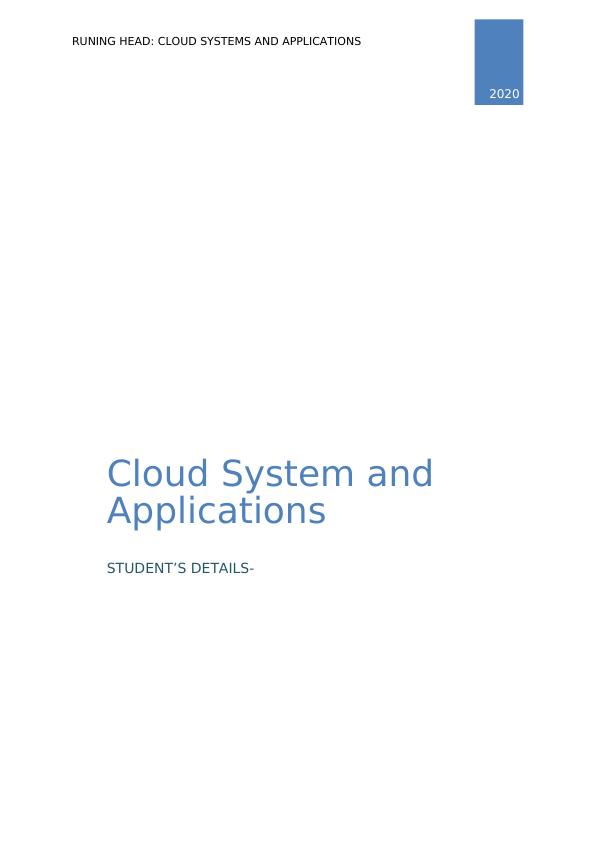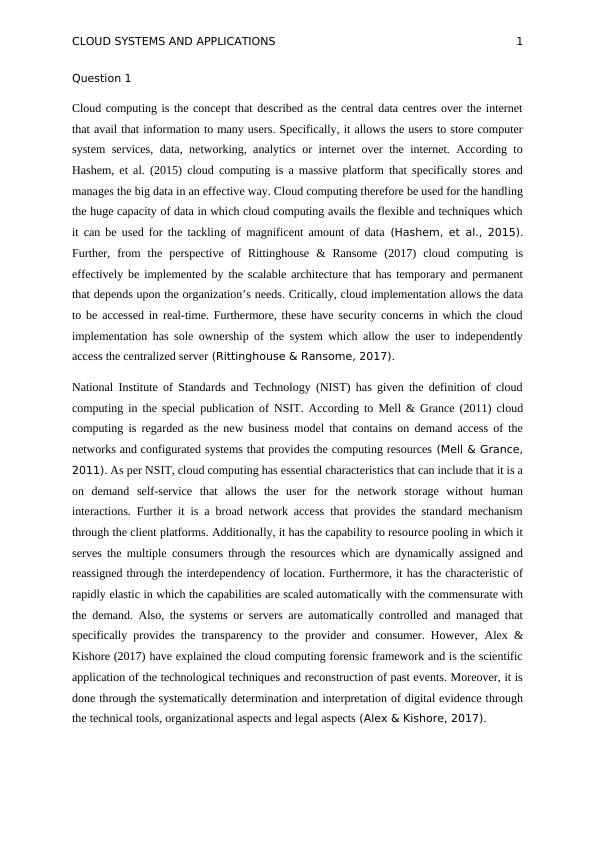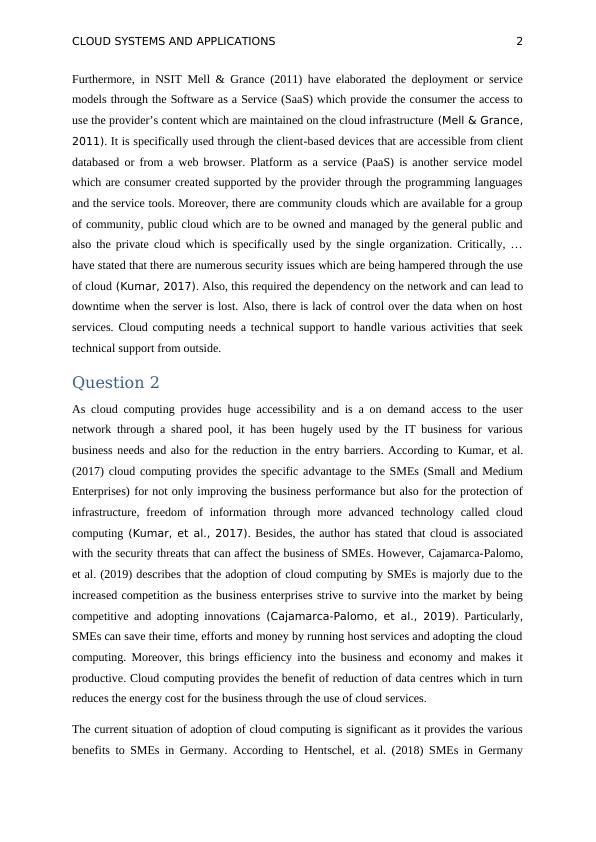Cloud Systems and Applications - Q&A
Added on 2022-08-14
8 Pages2987 Words14 Views
RUNING HEAD: CLOUD SYSTEMS AND APPLICATIONS 0
Cloud System and
Applications
STUDENT’S DETAILS-
2020
Cloud System and
Applications
STUDENT’S DETAILS-
2020

CLOUD SYSTEMS AND APPLICATIONS 1
Question 1
Cloud computing is the concept that described as the central data centres over the internet
that avail that information to many users. Specifically, it allows the users to store computer
system services, data, networking, analytics or internet over the internet. According to
Hashem, et al. (2015) cloud computing is a massive platform that specifically stores and
manages the big data in an effective way. Cloud computing therefore be used for the handling
the huge capacity of data in which cloud computing avails the flexible and techniques which
it can be used for the tackling of magnificent amount of data (Hashem, et al., 2015).
Further, from the perspective of Rittinghouse & Ransome (2017) cloud computing is
effectively be implemented by the scalable architecture that has temporary and permanent
that depends upon the organization’s needs. Critically, cloud implementation allows the data
to be accessed in real-time. Furthermore, these have security concerns in which the cloud
implementation has sole ownership of the system which allow the user to independently
access the centralized server (Rittinghouse & Ransome, 2017).
National Institute of Standards and Technology (NIST) has given the definition of cloud
computing in the special publication of NSIT. According to Mell & Grance (2011) cloud
computing is regarded as the new business model that contains on demand access of the
networks and configurated systems that provides the computing resources (Mell & Grance,
2011). As per NSIT, cloud computing has essential characteristics that can include that it is a
on demand self-service that allows the user for the network storage without human
interactions. Further it is a broad network access that provides the standard mechanism
through the client platforms. Additionally, it has the capability to resource pooling in which it
serves the multiple consumers through the resources which are dynamically assigned and
reassigned through the interdependency of location. Furthermore, it has the characteristic of
rapidly elastic in which the capabilities are scaled automatically with the commensurate with
the demand. Also, the systems or servers are automatically controlled and managed that
specifically provides the transparency to the provider and consumer. However, Alex &
Kishore (2017) have explained the cloud computing forensic framework and is the scientific
application of the technological techniques and reconstruction of past events. Moreover, it is
done through the systematically determination and interpretation of digital evidence through
the technical tools, organizational aspects and legal aspects (Alex & Kishore, 2017).
Question 1
Cloud computing is the concept that described as the central data centres over the internet
that avail that information to many users. Specifically, it allows the users to store computer
system services, data, networking, analytics or internet over the internet. According to
Hashem, et al. (2015) cloud computing is a massive platform that specifically stores and
manages the big data in an effective way. Cloud computing therefore be used for the handling
the huge capacity of data in which cloud computing avails the flexible and techniques which
it can be used for the tackling of magnificent amount of data (Hashem, et al., 2015).
Further, from the perspective of Rittinghouse & Ransome (2017) cloud computing is
effectively be implemented by the scalable architecture that has temporary and permanent
that depends upon the organization’s needs. Critically, cloud implementation allows the data
to be accessed in real-time. Furthermore, these have security concerns in which the cloud
implementation has sole ownership of the system which allow the user to independently
access the centralized server (Rittinghouse & Ransome, 2017).
National Institute of Standards and Technology (NIST) has given the definition of cloud
computing in the special publication of NSIT. According to Mell & Grance (2011) cloud
computing is regarded as the new business model that contains on demand access of the
networks and configurated systems that provides the computing resources (Mell & Grance,
2011). As per NSIT, cloud computing has essential characteristics that can include that it is a
on demand self-service that allows the user for the network storage without human
interactions. Further it is a broad network access that provides the standard mechanism
through the client platforms. Additionally, it has the capability to resource pooling in which it
serves the multiple consumers through the resources which are dynamically assigned and
reassigned through the interdependency of location. Furthermore, it has the characteristic of
rapidly elastic in which the capabilities are scaled automatically with the commensurate with
the demand. Also, the systems or servers are automatically controlled and managed that
specifically provides the transparency to the provider and consumer. However, Alex &
Kishore (2017) have explained the cloud computing forensic framework and is the scientific
application of the technological techniques and reconstruction of past events. Moreover, it is
done through the systematically determination and interpretation of digital evidence through
the technical tools, organizational aspects and legal aspects (Alex & Kishore, 2017).

CLOUD SYSTEMS AND APPLICATIONS 2
Furthermore, in NSIT Mell & Grance (2011) have elaborated the deployment or service
models through the Software as a Service (SaaS) which provide the consumer the access to
use the provider’s content which are maintained on the cloud infrastructure (Mell & Grance,
2011). It is specifically used through the client-based devices that are accessible from client
databased or from a web browser. Platform as a service (PaaS) is another service model
which are consumer created supported by the provider through the programming languages
and the service tools. Moreover, there are community clouds which are available for a group
of community, public cloud which are to be owned and managed by the general public and
also the private cloud which is specifically used by the single organization. Critically, ...
have stated that there are numerous security issues which are being hampered through the use
of cloud (Kumar, 2017). Also, this required the dependency on the network and can lead to
downtime when the server is lost. Also, there is lack of control over the data when on host
services. Cloud computing needs a technical support to handle various activities that seek
technical support from outside.
Question 2
As cloud computing provides huge accessibility and is a on demand access to the user
network through a shared pool, it has been hugely used by the IT business for various
business needs and also for the reduction in the entry barriers. According to Kumar, et al.
(2017) cloud computing provides the specific advantage to the SMEs (Small and Medium
Enterprises) for not only improving the business performance but also for the protection of
infrastructure, freedom of information through more advanced technology called cloud
computing (Kumar, et al., 2017). Besides, the author has stated that cloud is associated
with the security threats that can affect the business of SMEs. However, Cajamarca-Palomo,
et al. (2019) describes that the adoption of cloud computing by SMEs is majorly due to the
increased competition as the business enterprises strive to survive into the market by being
competitive and adopting innovations (Cajamarca-Palomo, et al., 2019). Particularly,
SMEs can save their time, efforts and money by running host services and adopting the cloud
computing. Moreover, this brings efficiency into the business and economy and makes it
productive. Cloud computing provides the benefit of reduction of data centres which in turn
reduces the energy cost for the business through the use of cloud services.
The current situation of adoption of cloud computing is significant as it provides the various
benefits to SMEs in Germany. According to Hentschel, et al. (2018) SMEs in Germany
Furthermore, in NSIT Mell & Grance (2011) have elaborated the deployment or service
models through the Software as a Service (SaaS) which provide the consumer the access to
use the provider’s content which are maintained on the cloud infrastructure (Mell & Grance,
2011). It is specifically used through the client-based devices that are accessible from client
databased or from a web browser. Platform as a service (PaaS) is another service model
which are consumer created supported by the provider through the programming languages
and the service tools. Moreover, there are community clouds which are available for a group
of community, public cloud which are to be owned and managed by the general public and
also the private cloud which is specifically used by the single organization. Critically, ...
have stated that there are numerous security issues which are being hampered through the use
of cloud (Kumar, 2017). Also, this required the dependency on the network and can lead to
downtime when the server is lost. Also, there is lack of control over the data when on host
services. Cloud computing needs a technical support to handle various activities that seek
technical support from outside.
Question 2
As cloud computing provides huge accessibility and is a on demand access to the user
network through a shared pool, it has been hugely used by the IT business for various
business needs and also for the reduction in the entry barriers. According to Kumar, et al.
(2017) cloud computing provides the specific advantage to the SMEs (Small and Medium
Enterprises) for not only improving the business performance but also for the protection of
infrastructure, freedom of information through more advanced technology called cloud
computing (Kumar, et al., 2017). Besides, the author has stated that cloud is associated
with the security threats that can affect the business of SMEs. However, Cajamarca-Palomo,
et al. (2019) describes that the adoption of cloud computing by SMEs is majorly due to the
increased competition as the business enterprises strive to survive into the market by being
competitive and adopting innovations (Cajamarca-Palomo, et al., 2019). Particularly,
SMEs can save their time, efforts and money by running host services and adopting the cloud
computing. Moreover, this brings efficiency into the business and economy and makes it
productive. Cloud computing provides the benefit of reduction of data centres which in turn
reduces the energy cost for the business through the use of cloud services.
The current situation of adoption of cloud computing is significant as it provides the various
benefits to SMEs in Germany. According to Hentschel, et al. (2018) SMEs in Germany

End of preview
Want to access all the pages? Upload your documents or become a member.
Related Documents
Security Threats in Cloud Computing and Preventive Methodslg...
|3
|553
|330
Cloud Computing for Smith Security Ltdlg...
|10
|665
|480
Management Assignment - Products and Their Useslg...
|5
|578
|45
Basics of Cloud Computing: Advantages, Disadvantages, and Economic Implicationslg...
|37
|3186
|252
State of Cloud Serviceslg...
|14
|3760
|76
BIT200 | Cloud Computing | IaaS | PaaS | SaaSlg...
|11
|2770
|52
